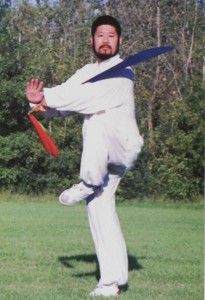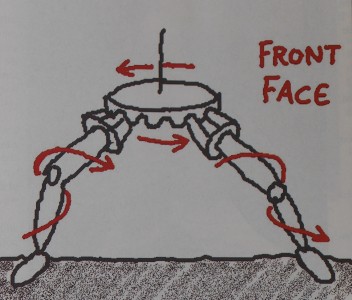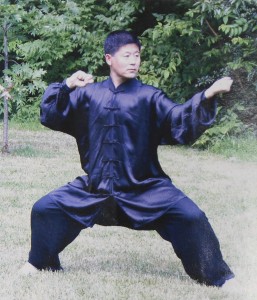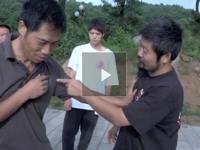*This article was originally published in T’ai Chi, the International Magazine of T’ai Chi Ch’uan, Vol. 29, No.5, October 2005. ISSN 0730-1049, Wayfarer Publications, Los Angeles, CA 90039.
Editor’s Note: The kua are central to the optimum practice of T’ai Chi Ch’uan, whether for health or self-defense. Yet they are largely misunderstood in their function and rarely used correctly.
In early years of practice they are usually not accessible to the understanding of practitioners.
Indeed, there are different understandings on how the two kua–located at the joint connecting the hips with the top of the upper leg bones–work, individually and together.
Often experts will describe the function of the kua differently based on their own experience. Sometimes their words are different but the meaning is the same. Sometimes the words and the meaning are different.
Chen Zhonghua (Joseph Chen) feels that coordinating two kua together produces the proper structural flow for Taiji form, power, root and whole body movement.
He explains the function of the kua in its relationship with activity of the dantian, which many commentators describe as the source of transfer of power.
While he agrees that the dantian serves to facilitate transfer of power, he emphasizes, that ability is dependent upon coordinated joint rotation of the kua, driven by leg action from the ground.
This article is in a question and answer format and is based on a seminar in which Chen Zhonghua explained the function of the kua, how to open the kua and training to improve the use of the kua.
This article presents Chen’s answers to students’ questions at his annual two-week summer workshop in Arkansas. The course material for the seminar was Hong Junsheng’s “Practical Method of Chen Style Tai Chi.” Chen is disciple of Hong and Feng Zhiqiang.
Most students were intermediate to advanced level. Training at the seminar emphasized mechanics and application skills. Following is a selection of the questions and answers about the understanding of the function and usage of the kua.
Anatomy and General Understanding
Student Question: It is quite common for teachers of the internal arts to emphasize the importance of the kua for attainment of higher levels of skill. What could you say about the kua in terms of its role in the practice of Tai Chi?
Chen Zhonghua: Its fundamental role is that without the kua the upper and lower body cannot properly work together. The kua are the body parts responsible for integration of upper and lower body.
Student Question: Can you give some description or details? In context of the hips, groin, pelvic girdle, or femur, speaking in simple layman’s view of anatomy–how would you describe the kua?
Chen Zhonghua: The kea is that ball joint inside, at the top of the thigh bone. I don’t know the English name for it (femur), the ball joint inside, inside the hip.
Student Question: The tops of the thigh bones that rotate?
Chen Zhonghua: Yes, the ball joint, that’s the kua.
The rest, the body parts connected with it, are just things associated with it. That’s why there is always confusion, why the understanding of it always changes.
At different levels you will be able to associate your kua with other parts of your body. It’s these various different perceptions of experience of the kua, that give rise to different explanations of the kua among different masters or teachers.
Student Question: When they talk about the kua, maybe their definitions are more in terms of its usage?
Chen Zhonghua: Yes. As you exercise that joint, it affects the structure and movement of your body. The better you are at using the kua, the better your body is coordinated. So it will appear that different masters use the kua differently, with varying levels and depth of experience of that function. Ability to connect the kua with better integration with the body reveals higher skill.
But the simple objective anatomical definition of the kua has not been wrong in the past. It is commonly understood to be that ball joint.

The Functional Relationship with Upper and Lower Body
Student Question: So great ability brings better coordination of kua with different parts of the body. Could you distinguish the role of the hips, the waist and the kua in terms of using it properly?
Chen Zhonghua: To properly use your kua you have to properly use the body parts around the kua. You have to use your hips correctly and use your two thigh bones, the femurs, correctly.
Also, you have to use your weight correctly and move your tail bone correctly. These are the things that are associated with it, so they must be considered. But these are “about” the kua, you cannot talk about it without considering the areas I just mentioned.
Student Question: Perhaps the area of the body that most frequently causes confusion about mechanics of correct Tai Chi practice is the role of the waist. Can you talk about the connection of the waist and the kua and the distinction between the waist and the kua in terms of usage?
Chen Zhonghua: In terms of function, it is better to emphasize the primary role of the kua, rather than the waist. On the surface, people view Tai Chi exercise in terms of the waist. Waist is what you see, but the work is done by the kua.
Consider the waist area from the kua, the crease in the two legs, (inguinal crease), from that portion all the way up to your arm pits. This whole body trunk, this one piece must be expressed, exercised as one piece.
Think of this one piece as a round cylinder sitting on top of two legs. It is the function of the kua to coordinate the two legs directing this one cylinder.
Student Question: Communication from the legs to that whole upper body?
Chen Zhonghua: The communication will never occur unless the kua is properly aligned.
Think of it like a physical machine. The “U joints” on the two thighs must adjust so the cylinder can be aligned correctly, adjusting in terms of length, angle and its ability to maneuver with “connectedness.”
The “connectedness” is very elusive and difficult. The requirement of the joint is to be connected to take full weight of the body, yet it must have flexibility to direct movement at all times. So it is similar to a universal joint. The kua must be able to carry the weight with a constant friction level and yet constantly changing direction, without disrupting the connection.
The Kua Guide Change of Direction
Student Question: How does the kua function to accomplish those different things?
Chen Zhonghua: The other body parts I mentioned earlier must come into play.
We must understand how they work together.
Now we are talking about the function of different body parts associated with the kua. The trunk, the waist and torso, must be erect. It sits squarely on top of the two legs and the kua joint guides the waist as it adjusts to actions involved in maneuvering, changing direction.
The two kua guide change of direction. The body trunk doesn’t guide, it adjusts to changing direction.
Like a log in water, the water can move, causing the log to move, not the log causing the water to move. The two kua must move in a manner directing upper body movement, not the other way around.
Recognize this major distinction. Most people mistakenly assign primary function to the waist. The waist actually is the base of this cylinder I talked about.
To view waist movement as primary, to view it as physically moving the cylinder, causing your legs to move–that’s wrong understanding. Leg movement causes the kua to move, thus causing the adjustment of the trunk
Student Question: Like the incorrect practice known as “noodling”? Too much waist movement, or the knees and the arms and shoulders are moving all over place, with no kind of strong connected root from the ground and power because the upper body is separated from the lower?
Chen Zhonghua: That’s right.
Student Question: This has been the most amazing discovery emerging from what you have taught us, over the course of this workshop. For so many years, books and instructions from teachers always seem to place all emphasis on the “guiding role of the waist.”
Mention is made of the necessity to “open the kua.” But no one has ever clarified details of how the waist is being directed by kua, as opposed to moving the waist, using the waist muscles–rather than being directed by adjusting mechanism of the kua.
Now it is clear why performance of form and difficulties in push hands practice have been less than satisfactory, with the undesirable quality mentioned. This is a starting point to get on the right track. Thank you very much.
Chen Zhonghua: You are welcome.

Integrative Function of the Kua
Student Question: Can you elaborate how the kua makes for the correct “connectedness” of the trunk, hands and arms being driven powerfully from the ground–as opposed to non connected “noodling”?
Chen Zhonghua: The critical element is the action of upper body in relation with lower body. The trunk must be set in a fixed position and cannot move independently. It can only rotate, or adjust to the action of the legs.
Action of the legs must be on the knees. When the knee moves, energy is propelled both ways. One portion goes to the feet right through the ground, the other portion into kua in directing the trunk. That is the proper action.
That is why beginners have excess knee movement. As they improve, movement of knees becomes smaller. With practice they learn to effectively make use of small movement to cause large changes in the body.
Student Question: Did you say that one knee is pushing while the other is pulling? one pushing the ground and the other pushing the kua?
Chen Zhonghua: The two knees: one must go up, one down. That is the physical action. At all times, the main source of power of the body must be two knees going one up and one down.
As skill develops, they may not appear to do so, but the action is still the same. As the player gets more advances, knee movement may be less obvious, but still the power must be initiated from the two knees.
Student Question: How do you distinguish that from saying the power is coming from kua, one pushing down and one pushing up?
Chen Zhonghua: Kua is the joint responsible for transmission of power. The mistaken notion of dantian acting as the transmission should be amended, to recognize the primary role of kua.
The dantian, (in Tai Chi functional terms, not qigong usage), is defined as the area between kua and the arm pits. This is one big ball. When this area turns you won’t see the kua turn.
On the surface, you only see the area from kua to arm pit turn. Therefore, many people practice shoulder movement, turning dantian from the top. We must emphasize turning of the dantian from the bottom.
Student Question: And that is from the knees pumping like pistons, one going down and one going up?
Chen Zhonghua: It is more precise than that, but at the beginner level it is important to know that the knees function like two pistons.

Kua Establishing Correct Usage of Dantian and Upper Body
Student Question: When you bring in the concept of the dantian, are you saying the kua is rotating on each side and the ball is staying centered?
Chen Zhonghua: Whatever the intended activity of the upper body may be, rotations of the two kua are coordinated so as to ensure the trunk sitting on top of them remains erected all the time.
How you do that each time varies, but the trunk must remain level, erect and suspended.
Student Question: It seems that the functional role of the abdominal area just above the kua, the dantian or whatever, this includes the whole waist?
Chen Zhonghua: Yes.
Student Question: So the waist really isn’t moving, it’s not moving up and down and not moving left and right. It’s staying in one place like a ball sitting on top of these two rotating balls under it?
Chen Zhonghua: I can give you a better word. It’s called “adjusting,” not moving.
The dantian area adjusts the movement or the actions of the kua area, driven by the knees.
At the same time, the dantian area can adjust to other movement, such as the shoulders being pushed or pulled by your opponent.
In any case, dantian doesn’t cause action. It adjusts to actions applied on to it.
Student Question: Would you also say it is the point in the center of the body that maintains that uprightness and equilibrium?
Chen Zhonghua: Yes, it maintains and it adjusts. It does not create action. But for most practitioners, due to incorrect understanding, they attempt to create the action from the waist.
Student Question: So you mean dantian should keep itself completely stable?
Chen Zhonghua: Yes, it is important that movement is initiated in the knees. Incorrect practice, attempting to initiate movement from dantian, leading to twisting the waist, the knee, the arms and everything.
The common mistakes in practice, wrong body mechanics such as the knee twisting sideways, are due to wrong application of kua, not connecting properly with associated body parts.
Student Question: So if the kua is open, one can get this action with the knees, one going to the ground, one going to the kua and adjusting with each other to allow the continual centered position of the dantian.
If the kua is too pinched, or closed, or compressed, however, you say it, then the knees will not be allowed to go down and up? If there is some twisting of the knee, does that mean the kua is resisting being open?
Chen Zhonghua: There are two ways to view it.
One, the kua is resisting, so the knee twists. Second, even if flexibility of the kua is adequate to allow correct action of the kua, incorrect action of the kua, incorrect action of the knees would push the kua out of alignment. It is necessary to develop the awareness of coordination of kua and knees.
Student Question: You have to learn how to coordinate them with each other to produce the alignment and the proper balancing?
Chen Zhonghua: Yes.
(To be continued in Part II: Functional Relationships of Kua, Dantian and Physical Structure; Function of Kua in the Transfer of Energy; The Key Role of the Kua in Meeting Unique Requirements of Tai Chi; Correct Usage of Kua, Establishing a Center for Advanced Tai Chi Skills; Practice for Developing Correct Ysage of Kua.)




{ 1 comment… read it below or add one }
Excellent article that clarified many the many complex relationships: ground , knees, kua, waist, dantian. I found the diagram extremely helpful. It would be interesting to use the points outlined in article to frame a discussion on John Upshaw’s recent breakthrough, discussed in a recent class.